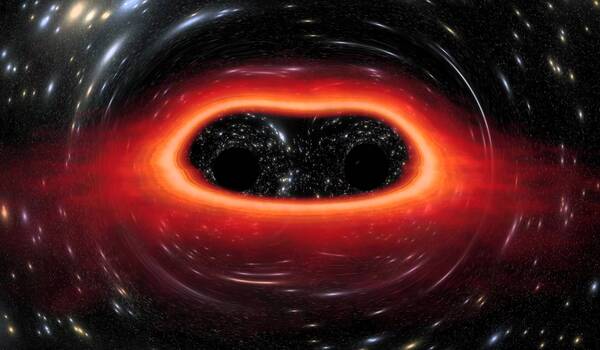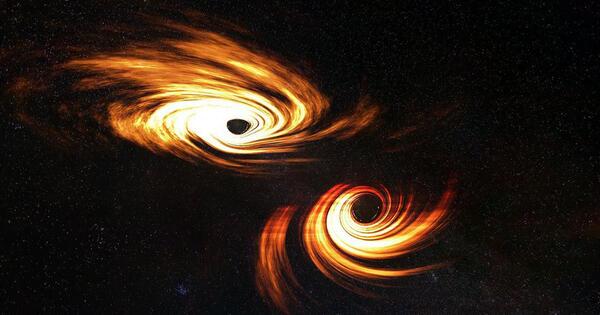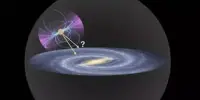A team of astronomers used archived data from the Gemini North telescope to measure the heaviest pair of supermassive black holes yet discovered. The merging of two supermassive black holes has long been anticipated, but never observed. This huge pair explains why such an event is so rare in the Universe.
Almost every big galaxy has a supermassive black hole in its center. When two galaxies merge, their black holes can form a binary pair, indicating that they are in a bound orbit around one another. It is believed that these binaries will eventually merge, however this has never been observed [1]. For decades, astronomers have debated whether such an occurrence is even possible. A team of astronomers recently published an article in The Astrophysical Journal that put new light on this subject.
The researchers used data from the Gemini North telescope in Hawai’i, one part of the International Gemini Observatory maintained by NSF’s NOIRLab, which is financed by the US National Science Foundation, to examine a supermassive black hole binary situated within the elliptical galaxy B2 0402+379. This is the only supermassive black hole binary that has yet been resolved in enough detail to see both objects separately [2], and it has the smallest direct observed separation of 24 light-years [3]. While this narrow separation suggests a powerful merger, more research found that the pair has been stuck at this distance for almost three billion years, raising the question: what’s the hold-up?
The data archive serving the International Gemini Observatory holds a goldmine of untapped scientific discovery. Mass measurements for this extreme supermassive binary black-hole are an awe-inspiring example of the potential impact from new research that explores that rich archive.
Martin Still
To better understand the dynamics of this system and its halted merger the team looked to archival data from Gemini North’s Gemini Multi-Object Spectrograph (GMOS), which allowed them to determine the speed of the stars within the vicinity of the black holes. “The excellent sensitivity of GMOS allowed us to map the stars’ increasing velocities as one looks closer to the galaxy’s center,” said Roger Romani, Stanford University physics professor and co-author of the paper. “With that, we were able to infer the total mass of the black holes residing there.”
The team estimates that the binary’s mass is 28 billion times that of the Sun, making it the heaviest binary black hole ever recorded. This measurement not only provides significant background for the binary system’s origin and the history of its host galaxy, but it also supports the long-held hypothesis that the mass of a supermassive binary black hole plays an important role in preventing a future merger [4].
“The data archive serving the International Gemini Observatory holds a goldmine of untapped scientific discovery,” says Martin Still, NSF program director for International Gemini Observatory. “Mass measurements for this extreme supermassive binary black-hole are an awe-inspiring example of the potential impact from new research that explores that rich archive.”

Understanding how this binary formed can help predict if and when it will merge — and a handful of clues point to the pair forming via multiple galaxy mergers. The first is that B2 0402+379 is a ‘fossil cluster,’ meaning it is the result of an entire galaxy cluster’s worth of stars and gas merging into one single massive galaxy. Additionally, the presence of two supermassive black holes, coupled with their large combined mass, suggests they resulted from the amalgamation of multiple smaller black holes from multiple galaxies.
Following a galactic merger, supermassive black holes don’t collide head-on. Instead they begin slingshotting past each other as they settle into a bound orbit. With each pass they make, energy is transferred from the black holes to the surrounding stars. As they lose energy, the pair is dragged down closer and closer until they are just light-years apart, where gravitational radiation takes over and they merge. This process has been directly observed in pairs of stellar-mass black holes — the first ever recorded instance being in 2015 via the detection of gravitational waves — but never in a binary of the supermassive variety.
With fresh understanding about the system’s extraordinarily massive mass, the scientists calculated that an exceptionally large number of stars would have been required to slow the binary’s orbit sufficiently to bring them thus close. In the process, the black holes appear to have ejected almost all of the matter in their neighborhood, leaving the galaxy’s core devoid of stars and gas. With no more material available to slow the pair’s orbit, their merger has reached its ultimate stage.
“Normally it seems that galaxies with lighter black hole pairs have enough stars and mass to drive the two together quickly,” says Romani. “Since this pair is so heavy it required lots of stars and gas to get the job done. But the binary has scoured the central galaxy of such matter, leaving it stalled and accessible for our study.”
It remains to be seen whether the duo will overcome their stasis and finally unite over millions of years, or if they will remain in orbital limbo indefinitely. If they merge, the gravitational waves will be a hundred million times stronger than those produced by stellar-mass black hole mergers. It’s feasible that the pair may bridge that remaining gap through another galaxy merger, which would inject more material into the system, or a third black hole, slowing the pair’s orbit sufficiently to combine. However, considering B2 0402+379’s status as a fossil cluster, another galactic merger seems unlikely.
“We’re looking forward to follow-up investigations of B2 0402+379’s core where we’ll look at how much gas is present,” says Tirth Surti, Stanford undergraduate and the lead author on the paper. “This should give us more insight into whether the supermassive black holes can eventually merge or if they will stay stranded as a binary.”
Notes
[1] While there is evidence of supermassive black holes coming within a few light-years of each other, it seems none have been able to overcome that final distance. The question of whether such an event is possible is known as the final-parsec problem and has been a topic of discussion amongst astronomers for decades.
[2] Previous observations have been made of galaxies containing two supermassive black holes, but in these cases they are thousands of light-years apart — too far to be in a bound orbit with one another like the binary found in B2 0402+379.
[3] Other black hole-powered sources exist with possible smaller separations, though these have been inferred using indirect observations and therefore can best be classified as candidate binaries.
[4] This theory was first put forth in 1980 by Begelman et al. and has long been argued to occur based on decades of observations of the centers of galaxies.
















